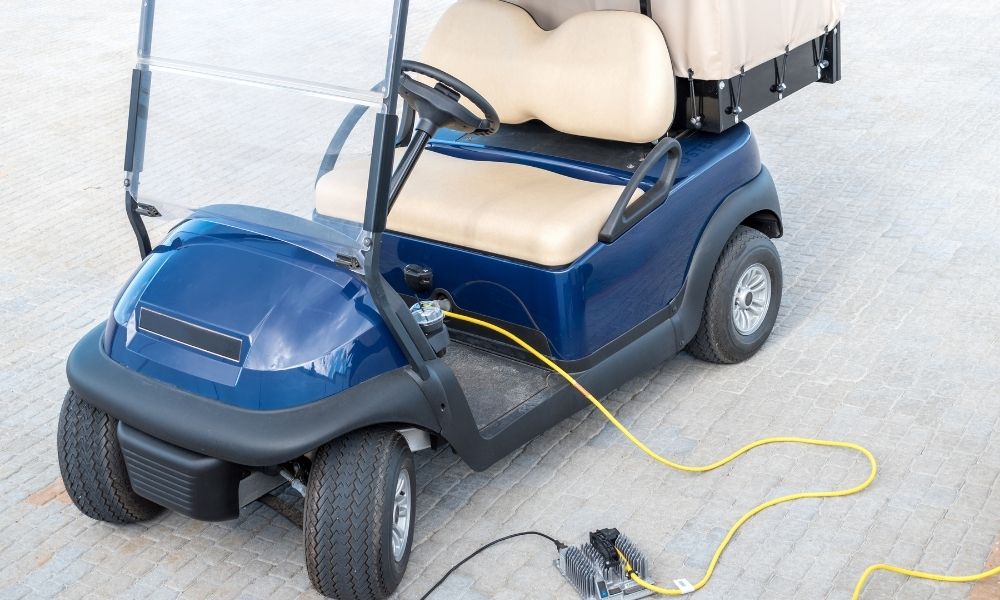A Step-by-Step Guide: How to Charge Golf Cart Batteries for Optimal Performance
Key Takeaway:
- Charging and maintaining golf cart batteries is crucial for their performance and longevity.
- There are two main types of golf cart batteries: deep cycle lead-acid batteries and lithium-ion batteries.
- When charging lead-acid batteries, it’s important to read the instructions, charge after every use, charge in a well-ventilated area, and regularly check voltage settings and water levels.
- Charging lithium-ion batteries requires reading the instructions, avoiding charging in extreme temperatures, turning off the cart while charging, and monitoring for overheating.
- Tips for proper battery maintenance include fully charging batteries after each use, keeping them clean, regularly watering them, using them often, properly storing and protecting them, and avoiding freezing and extreme heat.
- Signs that it’s time to replace golf cart batteries include reduced capacity, swelling or leakage, shortened run time, and low or uneven voltage readings.
Introduction
Charging and maintaining golf cart batteries is crucial for ensuring optimal performance and longevity. In this section, we will explore the importance of proper battery charging and maintenance, and how it directly impacts the overall efficiency and lifespan of golf carts. So, let’s dive in and discover the key factors that every golf cart owner should know to maximize the potential of their batteries.

Importance of charging and maintaining golf cart batteries
Golf cart batteries are super important! They provide power to drive the cart and operate its features. So, it’s vital to keep them charged and maintained.
Regular charging makes sure the batteries have enough energy. This prevents sudden power failures or reduced performance. Proper maintenance also increases the battery life. Plus, it saves money in the long run.
Charging and maintenance also contribute to safety. Ventilating areas reduces the risk of fumes. Read the instructions from the manufacturer for charging and maintenance. They’ll tell you important safety information.
Finally, choose the right battery type. Otherwise, you’ll be stuck with a paperweight!
Types of Golf Cart Batteries
There are different types of batteries that can be used for golf carts, each with its own unique characteristics. In this section, we will explore two popular options: deep cycle lead-acid batteries and lithium-ion batteries. By understanding the features and benefits of these batteries, you’ll be able to make an informed decision about which type is best suited for your golf cart. So, let’s dive into the world of golf cart batteries and explore these two sub-sections.

Deep cycle lead-acid batteries
Deep cycle lead-acid batteries are renowned for their durability and long-lasting performance. They can endure multiple deep discharges without greatly impacting capacity. With a chemical reaction between lead plates and sulfuric acid, they’re perfect for heavy-duty tasks. Plus, they’re more cost-effective than other battery types, making them a popular selection for golf carts.
But, upkeep and proper charging are essential to maintain these batteries. Neglecting this can lead to decreased battery life and damage. Plus, water levels must be monitored and adjusted, since electrolyte evaporates during charging/discharging. This can reduce the battery’s capacity. Overcharging or undercharging can also harm battery performance.
To keep the battery in good shape, it’s important to follow charging instructions and avoid extreme temperatures. Also, charge the battery post-use to avoid reduced capacity and shorter run time, per ‘How to Charge Golf Cart Batteries’.
Lithium-ion batteries
A table can provide insight into the features and advantages of lithium-ion batteries versus deep cycle lead-acid batteries.
| Features | Lithium-ion Batteries | Deep Cycle Lead-Acid Batteries |
|---|---|---|
| Energy Density | High | Lower |
| Weight | Lightweight | Heavier |
| Lifespan | Long | Moderate |
| Maintenance | No regular watering required | Regular maintenance required |
| Self-Discharge Rate | Low | Higher |
To make sure lithium-ion batteries are used correctly, it is essential to read instructions from the manufacturer before charging. Additionally, avoid charging in extreme temperatures. It’s also recommended to turn off the golf cart during charging to prevent overheating. Monitor for signs of overheating while charging, as this will protect the battery and cart.
For proper maintenance, charge lithium-ion batteries after each use. Also keep them clean and store in a safe place, away from extreme heat or cold. Finally, do not overcharge or discharge the batteries, as this can reduce their capacity and cause damage.
How to Charge Golf Cart Batteries
Looking to keep your golf cart batteries charged? Discover the best methods to charge golf cart batteries, including charging lead-acid batteries and charging lithium-ion batteries. Learn how to ensure optimal performance and extend your battery’s lifespan. According to the reference data provided, we’ll explore effective techniques and tips to help you keep your golf cart batteries ready for your next round.

Charging lead-acid batteries
- Read the instructions. Check the manufacturer’s guide for your battery model. It covers important charging methods and precautions.
- Recharge after each use. Leaving the battery discharged for long causes sulfation, which harms performance and capacity.
- Charge in a well-ventilated area. Lead-acid batteries generate hydrogen gas, which is flammable and dangerous. Ensure safe dispersal of these gases.
- Check voltage settings and water levels. Ensure your charger is compatible with your battery’s requirements. Also, maintain proper water levels within each cell.
- Monitor for overheating. Keep an eye on your battery for any signs of overheating. If you notice anything, stop charging and consult a professional.
It is also essential to maintain lead-acid batteries. Check water levels, keep them clean, avoid extreme temperatures, and do not overcharge or discharge them. This will enhance their lifespan and performance. Then, you can get extended run times and reliable performance on the course.
Read the instructions
John learnt the lesson of reading and following instructions when it came to charging and maintaining his golf cart battery. It can be vital for prolonged battery life, proper performance and safety.
To understand the instructions:
- Review the manufacturer’s guidelines that came with the battery charger.
- Understand any safety precautions outlined in the instructions.
- Follow the recommended charging procedures.
- Take note of any recommended charging times or intervals.
- If there are questions or concerns, contact the manufacturer or a professional.
Be aware of unique details provided in the manufacturer’s guidelines – special considerations for different batteries or additional steps required for optimal charging.
John initially didn’t read the instructions. His battery wasn’t running efficiently. He consulted the guidelines, followed them and saw a great improvement in his battery’s performance. This shows how important it is to read and stick to instructions for proper battery maintenance.
Charge after every use
Charge golf cart batteries after every use for good performance and longer lifespan. This prevents the batteries from being totally discharged, which can cause irreversible damage and a shortened life. Here’s a 3-step guide:
- Read instructions. Different models may need specific charging so understand any guidelines or warnings.
- Connect charger. Secure connections and check voltage settings if necessary.
- Monitor process. Don’t disconnect prematurely. Keep an eye out for overheating or other issues. Fully charged? Unplug.
Regularly top off charge to maintain performance and extend lifespan. Pro tip – store fully charged during extended inactivity to prevent discharge and damage.
Charge in a well-ventilated area
It is essential to charge golf cart batteries in a well-ventilated area. This keeps hazardous gases from building up, which can be dangerous. To do this, follow these steps:
- Pick an open, outdoor spot or a well-ventilated indoor area. This allows gases to disperse and stops inhalation risks.
- Make sure there are no flammable items or fire sources nearby. This keeps the charging environment safe.
- Position the golf cart so that air can flow easily around the battery compartment when charging.
- If charging indoors, open windows or use fans to circulate air.
- Don’t charge in enclosed spaces (such as garages or sheds) without ventilation – this can cause gas buildup and increase the risk of explosion or fire.
- Check the battery charger and cables for wear and damage before using. Faulty equipment can be dangerous even in a well-ventilated area.
Charging golf cart batteries in a well-ventilated area not only ensures safety, but also enhances battery performance and life. Adequate ventilation maintains optimal temperatures during charging, preventing overheating and shortening battery life.
By following these guidelines, you can ensure your golf cart batteries charge safely and effectively in a well-ventilated area. Safety must always be a priority when charging batteries – neglecting proper ventilation can lead to accidents or damage.
Learning from past experiences and taking safety precautions can help minimize risks associated with handling and charging golf cart batteries. To keep your batteries in good condition, regularly check the voltage and water level. After all, a well-maintained golf cart is like a reliable caddy – always ready to go!
Check voltage settings and water levels
Properly maintaining golf cart batteries is vital. Voltage settings and water levels must be monitored and adjusted for optimal performance and an extended lifespan. Here are some tips for proper battery maintenance:
- Read the instructions. For each battery type, there are specific voltage settings and water level requirements. Failing to follow the manufacturer’s instructions can damage the battery.
- Charge after every use. Recharging regularly prevents undercharging and overcharging which can harm the batteries.
- Charge in a well-ventilated area. Hydrogen gas may be produced during charging. This needs to disperse safely to avoid explosions.
- Check voltage settings. Make sure the charger is set at the correct voltage for the battery type. Incorrect voltage settings can damage the batteries.
- Check water levels. For lead-acid batteries, ensure the water covers the plates without overflowing. Adding distilled water prevents sulfation and improves performance.
Inspecting battery terminals for corrosion is also important. Corrosion can prevent proper power transfer, leading to poor performance. Cleaning them with baking soda and water can help.
One golfer learned the importance of voltage settings and water levels the hard way. After months of inconsistent charging practices, the run time of the cart decreased. Upon inspection, it was found that voltage settings were too high, causing overcharging and accelerated battery degradation.
Additionally, water levels were below the recommended level, further harming performance. This experience serves as a valuable reminder to regularly check and adjust settings for optimal operation.
Charging lithium-ion batteries
- Read the instructions. Understand the manufacturer’s guidelines. Specific requirements and precautions for each battery may apply.
- Avoid extreme temperatures. Don’t charge in hot or cold environments. Find a place with a moderate temperature.
- Switch off the cart. Before charging, switch off the golf cart to prevent electrical interruptions or hazards.
- Monitor for overheating. Keep an eye on the battery temperature while charging. Stop the process if you detect signs of overheating.
- Follow the voltage guidelines. Use the correct voltage settings for lithium-ion batteries. Check before charging to avoid damage.
Remember to consider any extra details specific to your battery model and charger. Plus, don’t overcharge or discharge your battery beyond its capacity. This will keep your battery running smoothly for longer.
Read the instructions
It is essential to read the instructions for charging golf cart batteries for optimal maintenance. Follow a step-by-step guide:
- First, read the manufacturer’s instructions.
- Charge the battery after each use.
- Do it in a well-ventilated space.
- Adjust voltage settings according to the instructions.
Remember to check for other details, such as precautions when charging in extreme temperatures and turning off the golf cart while charging. Golf Link Magazine advises following the instructions for safe and effective charging. Avoid trying to charge golf cart batteries in extreme temperatures – it won’t work.
Avoid charging in extreme temperatures
To guarantee proper charging and maintenance of golf cart batteries, it’s essential to dodge extreme temperatures. This can have a bad effect on the batteries’ performance and lifespan. To keep away from charging golf cart batteries in extreme temperatures, follow these 5 steps:
- Read up: Check the manufacturer’s instructions for temperature guidelines and warnings before charging.
- Optimal charging times: If you can, charge the batteries when it’s milder outside, like early morning or late evening.
- Shelter: If extreme temperatures can’t be avoided, try to charge the batteries in a shaded or covered area.
- Monitor temperature: Use a thermometer to monitor the battery compartment temp during charging. If it’s too high, take action or stop charging.
- Cool down: After charging in extreme temps, let the batteries cool down before using or recharging.
These steps will help protect your golf cart batteries from extreme temperature problems and ensure their optimal performance and longevity. Plus, extreme temperatures can affect other aspects of the batteries, such as voltage settings and water levels.
So, regular monitoring and maintenance are essential for proper functioning of your golf cart batteries in any weather. Don’t forget to turn the cart off while charging, or you might get an electric shock!
Turn off the cart while charging
To ensure a safe and effective charging process, turn off the golf cart when plugging it in. Here’s how to do it:
- Find a flat, stable surface for parking.
- Activate the parking brake.
- Turn off all electronic components.
- Disconnect the battery connections.
- Plug in the charger and follow manufacturer instructions.
Also, don’t overcharge or leave batteries on charge for long. This practice is important for optimal performance and longevity of your golf cart batteries. Lastly, keep an eye on the battery’s temperature to avoid a scorching golf cart!
Monitor for overheating
The importance of monitoring for overheating when charging golf cart batteries cannot be emphasised enough. This can cause damage or even failure of the batteries, which can be costly to replace and a safety risk.
To monitor and prevent overheating, these 3 steps are crucial:
- Read the instructions: Understand the manufacturer’s recommendations and guidelines for monitoring and preventing overheating during the charging process.
- Avoid extreme temperatures: High ambient temperatures can accelerate battery degradation. Charging in very cold temperatures can impact battery performance negatively. Charging should be done in the temperature range suggested by the manufacturer.
- Turn off the cart while charging: To monitor for overheating, turn off the golf cart while charging. This reduces electrical load on the charger and battery, maintaining an optimal temperature during the charge.
It is also helpful to keep an eye out for signs of overheating, like strange smells or heat coming from the battery compartment.
By following these steps and staying on the lookout for signs of overheating, golf cart owners can monitor effectively. This helps ensure safe charging, prolongs battery life, and maintains optimal performance.
Maintaining golf cart batteries is like keeping a spouse happy – charge them, keep them clean, and don’t let them overheat.
Tips for Proper Battery Maintenance
Proper battery maintenance is essential for keeping your golf cart running smoothly. In this section, we will discuss valuable tips to ensure the longevity and performance of your golf cart batteries. From fully charging batteries after each use to keeping them clean and properly watering them, we’ll cover all the necessary steps.
Additionally, we’ll explore the importance of using batteries often, storing them correctly, and avoiding extreme temperatures. Let’s dive into these essential battery maintenance practices to enhance your golf cart’s performance and extend its lifespan.
Fully charge batteries after each use
Proper charging of golf cart batteries is key. Not recharging them can lead to reduced power, shorter run times, and wear-and-tear. So, to maintain battery health, follow the right charging practices.
- Check instructions: Before charging, read the manufacturer’s guidelines and recommendations.
- Connect to charger: After using the golf cart, plug it into an appropriate charger. This keeps the batteries recharged and ready for next time.
- Ventilated area: When charging, make sure the area is well-ventilated. This prevents dangerous gas build-up and keeps the battery safe.
Apart from charging, check water levels regularly. Lead-acid batteries need to have electrolyte levels in the recommended range. Keep an eye on them and top up when needed for longer battery life and better performance.
Fully charging golf cart batteries after each use preserves battery health. In the past, people using electric golf carts found out that not recharging often causes decreased power and shorter run times. It became clear that fully charging after each use prolongs battery life and boosts performance.
Keep batteries clean
Keeping golf cart batteries clean is vital for their proper performance and life span. Dust, dirt and debris can cling to the terminals and impact how they work. Regularly cleaning them not only ensures a strong connection but also avoids corrosion building up.
These 6 steps will help keep golf cart batteries clean:
- Use a soft brush or cloth to get rid of any loose dirt or debris from the battery terminals.
- Make a paste with baking soda and water and apply it to the terminals. Scrub gently using a brush.
- Rinse the paste with clean water to take away any residue.
- Look over the cable for any wear or damage. Replace if needed.
- After cleaning, put a thin layer of petroleum jelly or a terminal protector spray on the terminals to prevent corrosion.
- Wipe down the outside of the batteries with a wet cloth to eliminate any remaining dirt or grime.
By following these steps often, you will make sure your golf cart batteries stay clean and work perfectly.
It is important to be careful when cleaning the batteries. Always use protective gloves and goggles in case of any acid spills or splashes. Also, avoid using too much water when rinsing off the battery terminals, as too much moisture can cause electrical problems.
Regularly water batteries
Properly caring for golf cart batteries involves regular watering. This helps maintain performance and life. To water batteries:
- Put on protective gloves and eyewear.
- Find the battery watering system or take off the vent caps, depending on the battery type.
- Fill each cell with distilled water until it reaches the manufacturer’s recommended level.
- Don’t overfill and make sure the water is below the fill well’s bottom surface, to stop electrolyte spray damage when driving.
- Wipe up any water spills on the battery top with a cloth or rag.
Tap water has minerals that can damage batteries and lead to early failure. So use distilled water only. Following these steps keeps golf cart batteries running well and lasting longer.
Use batteries often
Regular usage of golf cart batteries is key to maintain performance and prolong their lifespan. If they’re not used often, they can become weak and lose the ability to hold a charge. Therefore, ensure regular usage!
- Regular use helps avoid battery drainage and keeps cells active.
- Charging and discharging regularly maintains the chemical reactions inside cells, warding off sulfation.
- Using them often ensures all cells get equally exercised, minimizing the risk of single cells deteriorating faster.
For peak performance and extended life, use your golf cart batteries at least once a week or whenever possible. This will keep cells active and battery capacity high. Follow these guidelines and your golf cart’s batteries will remain in good shape!
Regular usage guards against battery drainage and chemical reaction issues such as sulfation. On top of that, it ensures all cells are equally exercised, reducing the risk of individual cell deterioration.
So don’t forget to use your golf cart batteries regularly to keep them in top condition and get the best performance from your golf cart. Regular use will increase their lifespan and ensure reliable power each time you ride. Keep your batteries safe, or you may have a problem!
Properly store and protect batteries
Practicing the right storage and protection for golf cart batteries is essential for their longevity. Stick to these instructions and you can guarantee safety and efficiency.
Store and guard your batteries with these 3 steps:
- Pick a suitable spot: Select a cool, dry area away from heat sources and direct sunlight. Provide adequate ventilation to stop the build-up of noxious gases.
- Clean and ready the batteries: Clean the battery terminals to remove dirt and corrosion. Make a paste of baking soda and water and use a wire brush to scrub. Ensure the terminals are completely dry before storing.
- Follow maintenance procedures: Keep the battery charged (normally 80%), check voltage settings, and fill up the water levels.
Plus, label each battery with its date of purchase or installation to trace its age and performance. When storing multiple batteries together, place them upright to avoid leakage or damage.
Follow these rules to extend battery life and ensure peak performance when using them. Don’t let your golf cart batteries be exposed to extreme temperatures and humidity or else they’ll turn into an ice cream truck or a vampire’s seat!
Avoid freezing and extreme heat
Freezing and extreme heat can be detrimental to golf cart batteries. To protect them, take precautions such as:
- Storing in a controlled environment.
- Avoiding direct sunlight.
- Regularly checking the temperature.
- Using insulation materials.
- Following manufacturer recommendations.
To ensure optimal performance and longevity, also follow proper maintenance practices, such as cleaning, avoiding overcharging/discharging, and checking water levels. Shockingly, overcharging or discharging can be just as destructive as hitting a water hazard!
Do not overcharge or discharge batteries
Overcharging or discharging golf cart batteries can be detrimental and should be prevented. Properly managing the process is essential to ensure long-term performance. Here are some key points to remember:
- Don’t overcharge: Too much charging can lead to increased heat and chemical reactions, damaging the internal components. Stick to the recommended time and voltage settings.
- Don’t over-discharge: Going beyond the recommended capacity may cause permanent damage to the cells, reducing performance and lifespan. Monitor the voltage regularly and recharge before it gets too low.
- Follow instructions: Each battery type has specific guidelines for optimal charging and discharging. Read and follow the manufacturer’s instructions carefully.
- Avoid extreme temperatures: Charging or discharging in extreme temperatures can reduce efficiency and lifespan. Opt for moderate temperature environments.
- Use a quality charger: Using a suitable charger made for golf cart batteries will ensure proper charging without overcharge or discharge. Invest in a high-quality charger to prolong battery life.
Also, don’t forget:
- Don’t leave batteries unattended while charging or discharging
- Disconnect the charger once the battery is full
- Check and maintain water levels in lead-acid batteries
- Store batteries in a cool and dry place when not in use
- Seek professional help if you have concerns about your golf cart batteries
By following these precautions, you can ensure the efficiency and performance of your golf cart batteries. Do this consistently and enjoy the capacity, run time, and overall functionality for a long time!
Signs it’s Time to Replace Golf Cart Batteries
Is your golf cart battery showing signs of wear and tear? In this section, we’ll discuss the telltale signs that indicate it’s time to replace your golf cart batteries. From reduced capacity to swelling or leakage, shortened run time, and low or uneven voltage readings, we’ll uncover the indicators that it’s time for a battery upgrade. Stay tuned to ensure your golf cart keeps running smoothly on the green!
Reduced capacity
Battery aging is a key cause of reduced capacity. Batteries naturally lose efficiency over time. This can be quickened by frequent use, wrong charging, or extreme temps. When capacity lessens, the golf cart performance can decrease.
To stop or minimize reduced capacity, proper battery maintenance is a must. Charging batteries after each use, avoiding overcharging/discharging, and keeping them clean and topped up with water – these are all ways to sustain their capacity.
It’s important to inspect the batteries regularly for signs of reduced capacity. Swelling or leakage can mean internal damage, affecting performance. Shortened run times and low/uneven voltage readings are signs that it’s time to replace them.
Swelling or leakage
Golf cart owners must inspect their batteries frequently. Looking for signs of lumpiness or leaks is important. If any are seen, then it’s time to take action. Replace or fix the affected batteries. Routine upkeep and solving swellings/leaks will help the battery run better and last longer.
Be informed! Swollen or leaking batteries must be changed instead of fixed. For safety reasons.
Keep your golf cart running and your patience on the course high!
Shortened run time
To battle run time shortening, take these steps:
- Recharge batteries after each use. Doing this will help maintain their peak performance and stop run time from decreasing. Follow the instructions that the manufacturer gives.
- Keep batteries clean. Doing this often will keep them working well and help them last longer. Use a damp cloth or special cleaning solution to wipe off any build-up on the battery terminals.
- Use batteries often. This helps stop them from wearing down over time. If they’re not used often, their performance and run time may be affected.
Also monitor signs of battery deterioration, like swelling, leakage, low voltage readings, or uneven voltage. Taking care of any issues with golf cart batteries will give them peak performance and a long life.
Low or uneven voltage readings
Low or uneven voltage readings can be a sign of potential issues that need attention. This directly influences the golf cart’s performance and power supply. Monitoring voltage levels is vital for optimal battery function and longevity.
- Low Voltage: Low readings mean the battery may not be charged enough. This leads to lower performance and shorter run times.
- Uneven Voltage Readings: Uneven readings across the battery pack suggest an imbalance. This affects power distribution and overall performance.
- Underlying Battery Issues: Low or uneven voltage readings could be due to sulfation (when a lead-acid battery isn’t fully charged regularly). This weakens the battery’s ability to hold a charge.
- Evaluation of Charging Methods: It is essential to evaluate and adjust charging methods if necessary. This includes using proper charging voltages/amperage and following manufacturer instructions.
- Regular Maintenance: Clean terminals, tighten connections, and check for corrosion regularly to prevent potential issues.
- Professional Inspection: If low or uneven voltage readings persist, have a professional inspect and diagnose any deeper underlying battery or electrical system problems.
Addressing low or uneven voltage readings quickly is key to avoiding further damage. Regular monitoring, maintenance, and correct charging practices are essential for optimal battery performance and a long battery life. So, keep your batteries in check to avoid a fore alarm fire!
Conclusion
After diving into the importance of caring for and maintaining golf cart batteries, let’s wrap up with some final thoughts and recommendations. Stay tuned to discover key insights and practical advice to optimize the lifespan and performance of your golf cart batteries. So, without further ado, let’s dig into the conclusion and see what it has in store for us.
Importance of caring for and maintaining golf cart batteries
Caring for & maintaining golf cart batteries is vital. This ensures optimal performance & long life. By following the proper care & maintenance practices, you can extend the battery lifespan & reduce the need for replacements.
Charge after each use for both deep cycle lead-acid & lithium-ion batteries. Charge in a well-ventilated area. Check voltage settings & water levels for lead-acid batteries. Follow manufacturer’s instructions for lithium-ion batteries. Turn off the golf cart when charging.
Also, fully charge after each use. Keep batteries clean from dirt & debris. Water lead-acid batteries regularly. Use batteries frequently so they don’t self-discharge. Store & protect during non-use. Monitor for signs of deterioration. Replace when needed.
In conclusion, following these practices is very important for battery longevity & performance. Golf cart owners can ensure reliable power sources for their carts this way.
Final thoughts and recommendations
Taking proper care of golf cart batteries is key for their long life and ideal performance. Whether lead-acid or lithium-ion, following the manufacturer’s instructions for charging and maintenance is important.
Charging after each use and avoiding their full depletion extends their life. Charging in well-ventilated areas stops gas buildup. Checking voltage settings and water levels for lead-acid batteries is essential.
For lithium-ion batteries, read manufacturer instructions carefully. Keep away from extreme temps during charging. Turning off the golf cart while charging prevents overheating.
In addition to charging:
- Fully charge after each use.
- Keep clean by removing dirt and debris.
- Water lead-acid batteries to replenish electrolyte levels.
- Use golf cart batteries regularly to prevent inactivity issues.
- Store and protect from freezing temps and extreme heat.
- Avoid overcharging or discharging the batteries.
Recognizing when it’s time to replace golf cart batteries is important. Signs include: reduced capacity, swelling/leakage, short run time, and low/uneven voltage readings.
To conclude, taking care of golf cart batteries involves proper charging techniques, regular maintenance, and recognizing signs of degradation. By following these recommendations, golf cart owners can ensure that their batteries provide reliable power on the course.
Some Facts About How to Charge Golf Cart Batteries:
- ✅ Golf cart batteries should be kept fully charged at all times to prevent damage and extend their lifespan. (Source: Team Research)
- ✅ New golf cart batteries should be charged every time they are used to extend their lifespan and prevent discharge. (Source: Team Research)
- ✅ It is recommended to charge golf cart batteries after every use, regardless of the duration of use. (Source: Team Research)
- ✅ It is not recommended to leave golf carts plugged in all the time as it can cause damage if the electrical circuit is overloaded. (Source: Team Research)
- ✅ Bubbling sounds during charging are normal for flooded lead-acid batteries but indicate damage for sealed batteries. (Source: Team Research)
FAQs about How To Charge Golf Cart Batteries
How often should I charge my golf cart batteries?
It is recommended to charge golf cart batteries after every use, regardless of the duration of use. This helps prevent damage and extends their lifespan.
Can I leave my golf cart plugged in all the time?
No, it is not recommended to leave golf carts plugged in all the time as it can cause damage if the electrical circuit is overloaded. It is best to charge them after each use and then unplug.
How do I charge a 36-volt battery pack with six 6-volt batteries?
To charge a 36-volt battery pack with six 6-volt batteries, you can charge each pair of batteries individually. This ensures that all the batteries in the pack are properly charged.
What is the proper way to charge an electric golf cart?
The proper way to charge an electric golf cart is to use the charger that came with it or find one that matches the vehicle’s specifications. Charge in a well-ventilated area with the golf cart switch set to the off position. Plug the charger into the power grid and the other end into the golf cart’s charging socket. Leave it plugged in until fully charged to avoid damaging the batteries.
How can I bring dead golf cart batteries back to life?
If golf cart batteries are completely dead, they can be brought back to life by manually charging them with a car battery charger. This can help revive the batteries and get them back to an operable condition.
What maintenance tasks should I perform to prolong the life of my golf cart batteries?
To prolong the life of golf cart batteries, you should fully charge them after each use, keep them clean, regularly check and maintain water levels, use the batteries often, avoid overcharging or discharging them beyond 80%, and store them properly.






